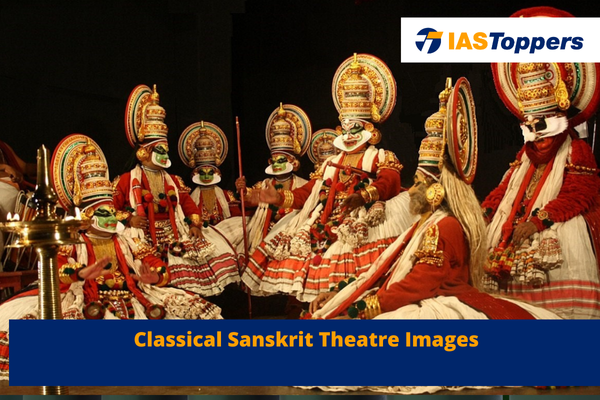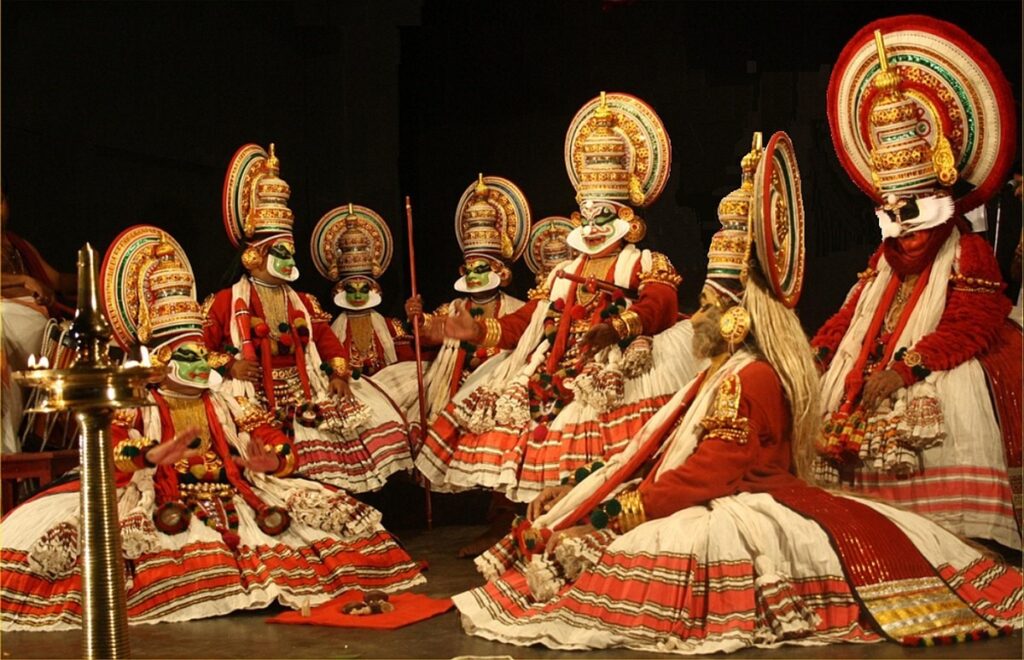The Classical Sanskrit Tradition, intrinsic to Indian theatre, was a harmonious mix of music, acting, and dance. Its key features included multilingual dialogues, diverse actor composition, and a standard five-phase plot structure. Though its popularity waned over time due to shifts in language preference, rigid conventions, and political changes, its influence is undeniable. In this article, you will know meaning of Classical Sanskrit Theatre, its features, ritualistic progression and its decline, all of which are important for GS Paper-1 Art & Culture of UPSC IAS Exam.
Table of Content
- Introduction
- Key features of Classical Sanskrit Tradition
- Ritualistic Progression of Sanskrit Theatre
- Characterization in Sanskrit Theatre
- Factors Leading to the Decline of Sanskrit Theatre
- Key Contributors to Classical Sanskrit Drama
- Conclusion
- FAQs on Classical Sanskrit Theatre
Introduction
- Indian theatre originated as a form of narrative art that combined elements of music, acting, and dance.
- The term ‘nataka‘ from Sanskrit, meaning ‘dancer‘, highlights the importance of dance in the art form.
- Other synonyms for drama in this context include Rupaka, Drishyakavya, and Preksakavya.
There were two primary categories of plays in the olden days:
- Lokadharmi: These were true-to-life portrayals of everyday activities.
- Natyadharmi: These plays were traditional, with a stylized storytelling approach and a greater emphasis on symbolism.
Key features of Classical Sanskrit Tradition
Classical Sanskrit theatre was characterized by certain defining features:
- Generally, these dramas contained between four to seven acts.
- In classical Sanskrit, plays were classified into 10 forms: Anka, Bhana, Dima, Ihamgra, Nataka, Prahasana, Prakarana, Svakarna, Vithi, and Vyayog.
- But Natya Shastr recognizes only two of these categories: Nataka and Prakarna.
- A common characteristic was their happy conclusion, with tragic endings being rather uncommon.
- Natyashastra presents the idea that a drama should also impart wisdom, facilitate prosperity, uphold justice, and pave the way towards spiritual enlightenment.
- This is one of the reasons why Sanskrit dramas avoid concluding with tragedies. The Hindu belief system views death as a stepping stone towards spiritual liberation, not a finality.
- A male character typically dominated the narrative, ultimately achieving his objective.
- Every performance had a clear and structured path, involving an introduction, development, pause, and resolution.
- Aesthetic sentiment, also known as Rasa, is a crucial component in Sanskrit theatre arts.
- Natyashastra further breaks down the various styles of theatrical performances. There are Rupakas or main plays, and Uparupakas, the subsidiary ones.
- A distinctive feature of Sanskrit drama is its multilingual character.
- Higher caste characters such as Brahmins and Kshatriyas converse in Sanskrit, while other characters from varied social strata – like soldiers, servants, women.
- Sanskrit drama sets itself apart from European classical drama in the assembly of actors.
- Unlike the exclusion of female performers in European drama, Sanskrit tradition allows for a more inclusive representation.
- There are no rules prohibiting male actors from playing female roles or vice versa. The cast can be entirely male, entirely female, or a mix of both.
Five-Phase Plot Structure in Sanskrit Drama
In Sanskrit drama, an ideal storyline develops through five stages leading to the climax of the plot.
- Mukha (Origin): Marks the plot’s beginning.
- Pratimukha (Incident): Helps develop the storyline by introducing both positive and negative occurrences.
- Garbha (Germ): Where good events/actions pave the way towards the ‘Aim’ (Phala).
- Vimarsa (Crisis): Brings in negative events/actions that seem to deviate from the aim.
- Nirvahana (Completion): All narrative threads in the play come together to reach a definitive end.
Ritualistic Progression of Sanskrit Theatre
These dramas also followed a specific ritualistic order:
- The performance started with various pre-play customs, known as purva-raga, mostly conducted behind the curtain.
- The Sutradhar, or stage director, would then make his entrance with his crew, offering prayers to the gods for blessings.
- Subsequently, the lead actress was introduced and the Sutradhar announced the details of the performance and the playwright.
- The theatre could host about 400 people.
- Stage had two levels: the upper level symbolized the heavens, while the lower level represented the earth.
- Curtains were used for dramatic effect, but the use of masks was not common.
Characterization in Sanskrit Theatre
Characters in these performances were key, categorized into three types:
- Nayaka (Hero): The Nayaka or the hero, depicted various personas such as kind-hearted (Lalita), calm and composed (Shanta), or agitated and arrogant (Uddhata). Some also portrayed the antagonist (Pratinayaka) such as Ravana, Duryodhana, etc.
- Nayika (Heroine): Nayika was generally portrayed as a queen, friend, courtesan, or divine lady.
- Vidusaka (Clown): Vidusaka played as a noble and kind-hearted character, often a companion to the hero. This character, through humor, often challenged societal norms. Unlike others who spoke Sanskrit, the Vidusaka used Prakrit.
- Thus, Sanskrit drama became a fusion of leisure and religious customs.
Factors Leading to the Decline of Sanskrit Theatre
Sanskrit theater’s decline can be attributed to several factors:
- A shift in Sanskrit playwrights’ focus towards lyrical writing led to a preference for this style over drama.
- The strict adherence to conventions in Sanskrit theatre stifled the creativity of emerging playwrights, leading them to explore other forms.
- As Sanskrit became increasingly ornate, it lost its appeal to the general public. It was largely used in religious contexts and by the Brahmin community, while languages like Pali and Prakrit became more widespread.
- The rise of Muslim rulers saw a diminished role for Sanskrit theatre, as dance and music gained more favor.
Key Contributors to Classical Sanskrit Drama
- Sanskrit theatrical tradition owes its legacy to eminent playwrights such as Sudraka, Bhasa, Bhavbhuti, Harsha, and Kalidasa among others.
- Most of these playwrights were in royal favor, serving in royal households or even being monarchs themselves.
Bhasa
- Bhasa, who lived between the 3rd and 4th centuries CE, was a Sanskrit playwright from Ujjain, predating Kalidasa.
- His work remained largely unknown until 1909 when Pandit Anandalvar of the Archaeological Survey of Mysore discovered the play “Swapnavasavadatta.”
- Bhasa found inspiration in the Mahabharata, the Ramayana, the Purana, and semi-historical legends.
- Bhasa’s plays do not follow the Natyashastra very strictly, even breaking dramatic conventions.
- This has led some critics to conclude that Bhasa’s plays were written before Bharatamnuni’s treatise, others see this as an indication of Bhasa’s poetic experiments.
- His best-known play, “Swapnavasavadatta,” fuses romance and political intrigue.
- It narrates story of King Udayana, who must choose between marrying for love his beloved Vasavadatta or the daughter of a neighboring king, Princess Padmavati, for political gain.
- Bhasa also penned short plays, one-act plays, and monologues.
- Bhasa was unconventional, often ending his plays tragically.
- “Uru-bhanga” and “Karnabhara” shwos this with their tragic endings, offering sympathetic portrayals of traditional villains from the Mahabharata.
- Bhasa showed violent acts onstage, breaking another Natyashastra convention.
Sudraka
- Sudraka was a poet-king from Ujjain in the 2nd century CE.
- He is best known for his play Mrichchhakatika (The Little Clay Cart), which is an extended version of Bhasa’s incomplete play Charudattam (Charudatta).
- This ten-act play narrates the love story of a Brahmin merchant and a courtesan Vasantasena, a story filled with romance and humor.
- Besides offering view of the urban society of the time, the play also presents a detailed look into the social structure.
- Sudraka’s other works include “Vinavasavadatta” and “Padmaprabhritaka.”
Bhavabhuti
- Bhavabhuti was the court poet of King Yashovarman of Kannauj in north India during the 8th century CE.
- He was recognized for his contributions to plays drawn from the epic Ramayana.
- For instance, the “Mahaviracharita” (Exploits of a Great Hero) delved into Rama’s early years, while the “Uttaramcharita” showcased his final years, as depicted in the Ramayana’s Uttara Kanda.
- These seven-act plays were written in the Nataka style.
- Another distinct work by Bhavabhuti is “Malatimadhava,” a Prakarana play based on the love story of Malati, a minister’s daughter, and her lover Madhavya.
- Bhavabhuti’s writing style often involved long poetic descriptions, which were unique to his simple and clear narrative.
- Bhavabhuti’s plays lack the traditional comic figure, vidusaka, indicating his inclination towards less humorous depictions.
- Instead, his work showcased an intriguing mix of the supernatural and the grotesque, often invoking feelings of disgust (Bibhasta) and anger (Raudra).
- His creative fusion of heroism, romance, and horror sets him apart in the Sanskrit literature.
Kalidasa
- Kalidasa revitalized the stories of Vedas, the Purana, and epic narratives.
- His wrote plays such as “Malavikagnimitram,” which explores the relationship between Malavika and Agnimitra, and “Vikramorvasiyam,” centering on Vikrama and Urvashi.
- Apart from plays, Kalidasa also penned epic poems including
- “Raghuvamsa” tracing the lineage of Raghu, and
- “Kumarasambhava” narrating the birth of Kumara or Subrahmanya, along with several Khandakavyas (minor poems).
- His most recognized and revered work is “Abhijnana Shakuntalam” or “The Recognition of Shakuntala.”
- Kalidasa’s plays distinctly portray the conflict between desire and duty.
Other significant plays include:
- Sariputraprakarana by Ashvaghosha.
- This was a nine-act play and is acknowledged as the first instance of classical Sanskrit drama.
- Mudrarakshasa by Visakhadatta,
- Ratnavali by Harshavardhana.
Conclusion
Classical Sanskrit Theatre has a rich history that has significantly influenced Indian performing arts. Its unique narrative structures, and multilingual representation, coupled with an emphasis on Rasa and flexibility in actor composition, have enriched its allure. However, its decline was inevitable due to shifts in linguistic preference, creative constraints, and political changes. Despite this, the legacy of this tradition lives on through the works of eminent playwrights such as Bhasa, Sudraka, Bhavabhuti, and Kalidasa, who have left an indelible mark on the world of drama and literature
Ref: Source-1
| Other Articles in History & Culture | |
| Left-Wing Movement in India | Ellora Caves |
| Pala Art and Architecture | Hoysala Empire |
| Hindustani Music | Kuchipudi |
FAQs(frequently asked question)
What are the key features of Classical Sanskrit Theatre?
Classical Sanskrit Theatre is characterized by its structured plot progression, multilingual character, inclusive representation of actors, and a strong emphasis on happy conclusions and spiritual enlightenment
Who were the key contributors to Classical Sanskrit Drama?
The key contributors to Classical Sanskrit Drama were eminent playwrights such as Sudraka, Bhasa, Bhavbhuti, Harsha, and Kalidasa.
What led to the decline of Sanskrit Theatre?
The decline of Sanskrit Theatre can be attributed to a shift towards lyrical writing, strict adherence to conventions, the ornate nature of Sanskrit leading to its limited appeal, and the rise of Muslim rulers who favored dance and music over theatre.
What were the key phases in the plot structure of Sanskrit drama?
The plot structure in Sanskrit drama typically progresses through five stages: Mukha (origin), Pratimukha (incident), Garbha (germ), Vimarsa (crisis), and Nirvahana (completion), which collectively lead to the final resolution of the story
How did Sanskrit Theatre differ from European classical drama?
One of the key differences lies in the composition of actors. Unlike European classical drama, which often excluded women, Sanskrit theatre had no such restrictions, allowing for a more inclusive representation with both male and female performers.



